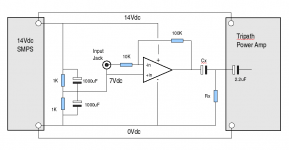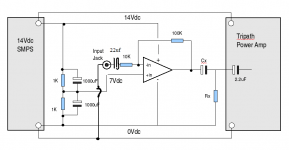Hello All,
Two days ago I breadboarded up a TL071 op-amp to boost the signal from an MP3 player in order to drive a small Tripath TA2020 amplifier board I purchased from Mr. Arjen Helder. As seen in the attached digram, this simple circuit uses the op-amp in a "inverting" configuration with a "virtual ground" powered off a single-rail 14 Volt / 3.5 Amp SMPS.
What puzzles me is that on my first day of testing this thing, it worked just fine without the coupling capacitor "Cx" and resistor "Rx". I played music for hours and the both the Tripath heat sink and the SMPS ran quite cool. The next day (with no modifications) the Tripath and the SMPS started to get very warm over a period of time, to the point the Tripath's self-protection features shut it down. Sometimes it only took 15 minutes for the amp to get hot and trip. Other times it took about an hour.
So, I tried several things to cure the problem, but adding in Cx and Rx seem to do the trick. I'm just not sure what changed between day one and now. Any suggestions and alternate solutions would be most welcome.
Two days ago I breadboarded up a TL071 op-amp to boost the signal from an MP3 player in order to drive a small Tripath TA2020 amplifier board I purchased from Mr. Arjen Helder. As seen in the attached digram, this simple circuit uses the op-amp in a "inverting" configuration with a "virtual ground" powered off a single-rail 14 Volt / 3.5 Amp SMPS.
What puzzles me is that on my first day of testing this thing, it worked just fine without the coupling capacitor "Cx" and resistor "Rx". I played music for hours and the both the Tripath heat sink and the SMPS ran quite cool. The next day (with no modifications) the Tripath and the SMPS started to get very warm over a period of time, to the point the Tripath's self-protection features shut it down. Sometimes it only took 15 minutes for the amp to get hot and trip. Other times it took about an hour.
So, I tried several things to cure the problem, but adding in Cx and Rx seem to do the trick. I'm just not sure what changed between day one and now. Any suggestions and alternate solutions would be most welcome.
Attachments
After looking at TA-2020 data sheet (http://www.e-ele.net/DataSheet/TA2020.pdf) it looks like the the inputs to the TA-2020 are biased at 1/2 the 5V analog supply (2.5V) and from the application note are decoupled from the input with a 2.2*uF electrolytic capacitor. When you hooked up your preamp the first time you were supplying 4.5V
( 7V virtual gnd - 2.5V bias) across the 2.2uF capacitor with a reverse polarity. After a while the 2.2uF became leaky or shorted (electrolytic capacitors don't like reverse voltages). This is why your Cx Rx fix worked.
( 7V virtual gnd - 2.5V bias) across the 2.2uF capacitor with a reverse polarity. After a while the 2.2uF became leaky or shorted (electrolytic capacitors don't like reverse voltages). This is why your Cx Rx fix worked.
Hi Obe1
RJM has the answer for your problem.
Another thought... nothing to do with the above... concerning the power amp 0volt line ?
If the amp when you have finished it has a mains safety earth that also connects to the PSU (and that 0 volt line), then you have a potential (as in a real potential 🙂) problem.
Do you see how your input ground is at 7 volts relative to that 0 line.
The problem would occur if ever the amp were connected to a piece of mains powered kit (CD player say) that also had a mains earth. That would then short out the "virtual" 7 volt ground.
It's easy to fix... your circuit is correct. All you do is AC couple the input to the opamp by including a cap of say 22uf in series with the 10k positive end to the opamp and change the ground connection as shown. Also then add (not shown) a resistor of say 470 k across the input socket (from cap negative to zero volt) to precisely define the operating conditions for the cap.
Doing that puts all the signal grounds on one level 🙂
It might be worth increasing the 10k and 100k resistors, scaling them up to say 47k and 470k. That would give increased input impedance and means you could then reduce that input coupling cap by a similar amount to say 4.7uf. The noise penalty of increased values would be minimal compared to the noise from the tripath.
Most modern stuff would have no problem driving 10k... old stuff might... so it's just for compatability really to do that.
RJM has the answer for your problem.
Another thought... nothing to do with the above... concerning the power amp 0volt line ?
If the amp when you have finished it has a mains safety earth that also connects to the PSU (and that 0 volt line), then you have a potential (as in a real potential 🙂) problem.
Do you see how your input ground is at 7 volts relative to that 0 line.
The problem would occur if ever the amp were connected to a piece of mains powered kit (CD player say) that also had a mains earth. That would then short out the "virtual" 7 volt ground.
It's easy to fix... your circuit is correct. All you do is AC couple the input to the opamp by including a cap of say 22uf in series with the 10k positive end to the opamp and change the ground connection as shown. Also then add (not shown) a resistor of say 470 k across the input socket (from cap negative to zero volt) to precisely define the operating conditions for the cap.
Doing that puts all the signal grounds on one level 🙂
It might be worth increasing the 10k and 100k resistors, scaling them up to say 47k and 470k. That would give increased input impedance and means you could then reduce that input coupling cap by a similar amount to say 4.7uf. The noise penalty of increased values would be minimal compared to the noise from the tripath.
Most modern stuff would have no problem driving 10k... old stuff might... so it's just for compatability really to do that.
Attachments
Hello RJM,
Thanks for clearing that up. While I don't have a schematic of how Mr. Helder built this amp, I could clearly see a large pair of tubular / film type coupling caps on the signal input pins, so I thought I was OK. Guess not.
Best regards,
Obe1
Thanks for clearing that up. While I don't have a schematic of how Mr. Helder built this amp, I could clearly see a large pair of tubular / film type coupling caps on the signal input pins, so I thought I was OK. Guess not.
Best regards,
Obe1
Hi Mooly,
Thanks for the ideas. Since the input sources for this project are targeted at portable / battery operated devices, I was happy to do away with the input coupling cap. But just to be safe, I'll look at adding them in as you suggested. I'll also look at bumping up my Rin and Rf values.
FYI: All of this work is still in the breadboard stage with all the parts & pieces siting open on a plank of wood, so I don't have anything (yet) tied to a real Earth (PE) ground.
Take care!
Obe1
Thanks for the ideas. Since the input sources for this project are targeted at portable / battery operated devices, I was happy to do away with the input coupling cap. But just to be safe, I'll look at adding them in as you suggested. I'll also look at bumping up my Rin and Rf values.
FYI: All of this work is still in the breadboard stage with all the parts & pieces siting open on a plank of wood, so I don't have anything (yet) tied to a real Earth (PE) ground.
Take care!
Obe1
- Status
- Not open for further replies.

